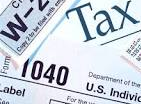Knowing your tax rate can
help you prepare a tax return and take action(s) to reduce your tax liability. Do
you know your federal income tax rate? You may actually have several different
tax rates (e.g., ordinary income, dividends, long-term capital gains),
depending upon sources of taxable income. This post describes the different
federal tax rates that apply to taxpayers.
Ordinary Income Tax Rate-
The seven
federal income tax brackets for ordinary income (e.g.,
salary/wages, interest income, short-term capital gains, and RMDs (withdrawals)
from tax-deferred retirement plans) in 2022 and 2023 are 10%, 12%, 22%, 24%,
32%, 35%, and 37%.
These tax rates apply currently
through 2025 under the Tax Cuts and Jobs Act. Income taxes are progressive (i.e.,
higher percentage of income for higher income earners) and taxpayers pay
different tax rates on different tiers of income up to their last dollar
earned.
Long-Term Capital Gains (LTCG)
Rate-
This is the tax rate assessed on profit from the sale of a capital asset (e.g.,
stock, bonds, mutual funds, property). To benefit from long-term capital gains
rates, an asset must be held for more than a year (e.g., a year and a day or
longer).
Current LTCG tax rates
are 0%, 15%, and 20% and, like ordinary tax rates, they rise with income. The
capital gain on the sale of an asset is calculated by subtracting its cost
basis (initial deposit + subsequent deposits + commissions/fees to purchase the
asset) from its sales price.
Capital Gains on Homes-
There is special rule for capital gains from the sale of a primary residence
that is owned and used for at least two of the last five years prior to its
sale. Single tax filers can exclude up to $250,000 of capital gain and joint
filers can exclude up to $500,000.
Qualified Dividend Tax
Rate-
This is the tax rate assessed on qualified dividends that are distributed by a
taxpayer’s investments (e.g., stocks and mutual funds) in taxable (i.e.,
non-retirement) accounts. Like ordinary and LTCG tax rates, taxes on dividends
are progressive.
The current tax rates
assessed on qualified dividends (which are reported as such by account
custodians) are 0%, 15%, and 20% depending on tax filing status (e.g., single,
couple filing jointly, head of household,) and income. Ordinary dividends are
taxed at ordinary tax rates.
Effective Tax Rate- While not an “official” tax rate that people use on their income tax returns, this is a very useful metric to analyze what percentage of your taxable income is being spent on federal income taxes. Many people also use their effective tax rate to estimate tax withholding. The formula for determining someone’s effective tax rate is Tax Liability divided by Taxable Income.
Examples: $5,000 ÷ $45,000 = 11.1% and $40,000 ÷ $245,000 = 16.3%.
In summary, it is not enough to simply
prepare your taxes to determine if you receive a refund or write a check to the
IRS. Take the time to examine the tax rates that affect your income.
This post provides
general personal finance or consumer decision-making information and does not
address all the variables that apply to an individual’s unique situation. It does
not endorse specific products or services and should not be construed as legal
or financial advice. If professional assistance is required, the services of a
competent professional should be sought.






No comments:
Post a Comment